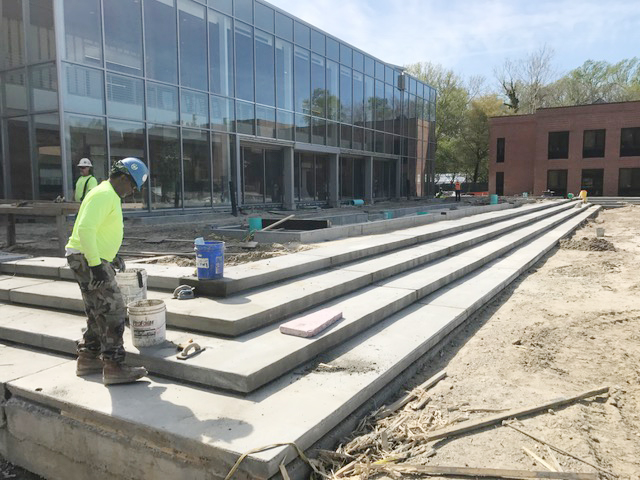Construction of the new sciences center and other projects at VWC continue despite vandalization to the new greenhouse
Construction of the Greer Environmental Sciences Center was briefly interrupted when the greenhouse, a key environmental feature of the Center, was vandalized on April 11.
A state-of-the-art facility centered around ecological, environmental awareness and sustainability, the Greer Environmental Sciences Center is one of the newest additions to the Virginia Wesleyan campus. Currently under construction, the facility is set to open in August of the 2017-2018 academic year.
The incident involved an unknown person entering the construction site and throwing several bricks at the newly-constructed greenhouse. The bricks shattered two panels of glass and caused an estimated $1,500 worth of damages. This estimate was provided by Vice President Emeritus and Director of Capital Projects Bruce Vaughan.
Senior Project Manager Clarke Lambert described the damage as “relatively minor” and stated that he was “disappointed” but remains optimistic that construction would go on as planned.
“For a project of this size and nature to have one incident, it’s not bad,” Lambert said.
Lambert also stated that he was relieved no one was harmed by the vandalism.Vaughan shares in Lambert’s disappointment.
“Our students have been very respectful of our construction sites, up until last night,” Vaughan said. “It’s just not necessary. We’re all adults on this campus.”
Vaughan also added that incidents of vandalism negatively affect students. As Hourigan Construction increases the cost of future projects with VWC to account for the possibility of vandalism, tuition costs rise for students as the college seeks to compensate for these financial losses.
It is presumed that the perpetrator is a current student and that the vandalism was carried out sometime between 5 p.m. and 6 a.m. Anyone with information regarding the vandalism is strongly encouraged to contact the security office.
Speculation about the motive for the vandalism ranges from student discontent over parking squabbles with construction workers to protests regarding the campus renovations. Alcoholic intoxication and pranks have also been suggested as reasons for the damage.
“To me, that’s really disrespectful because that’s destroying something of value to students and staff…People want to appreciate something so small, like a greenhouse,” Zachary Drake, president of Marlins Go Green said.
The glass panels have since been replaced and security cameras are now installed at the construction sites.
As the greenhouse is completed once again, construction continues on schedule for the rest of Greer Center. Besides the greenhouse and research gardens contained therein, other environmentally conscious aspects of the Center include an extensive green roof and landscaping that will feature native plants and wildlife habitats. The college’s website describes these three key areas as “strategically-placed sustainable features accessible to students.”
“It’s a dream come true for this campus,” said President Miller, who has been closely involved in the project and encouraged environmental sustainability on campus, said. “They’re on schedule, within budget—everything has worked beautifully,” Miller said.
Miller also negotiated a partnership with Norfolk Botanical Gardens, which he described as a “win-win situation.” The Gardens will provide the plants for the rooftop gardens, which will be installed in September. Horticulturalists will also be provided to care for the gardens and educate students and staff.
“When the building was designed, it was designed that the sustainable elements would be something students could learn from, they could study, they could monitor, they could adjust… We didn’t put in green things just to be green, it was so students could benefit from them,” Suzanne Savage, associate vice president for college advancement, said.
The greenhouse will cover roughly 800 square feet and also feature two main areas dedicated to arid and tropical plants.
The green roof will be on the south side of the Center inside a restricted area in order to protect the plants, although professors will be able to access the area for educational purposes. Students may observe the plants from a platform set on the border of the green roof, or a crosswalk connecting the roof to the observation deck.
Landscaping around the building will feature native habitat gardens, wetland gardens and cypress bogs containing 13 trees. An oak grove, tulip poplar grove and meadow garden will also be planted.
“This building has about five times the plants that you would usually get with a building of this size… All the plantings are designed to treat the quality of the stormwater runoff,” Lambert said.
Virginia Wesleyan College is also applying for Leadership in Energy and Environmental Design (LEED) certification from the United States Green Building Council, a non-profit organization promoting environmental sustainability in building design, construction and operation. There are three LEED certifications awarded: silver, gold and platinum. The administration is planning to apply for gold certification for the Greer Center.

